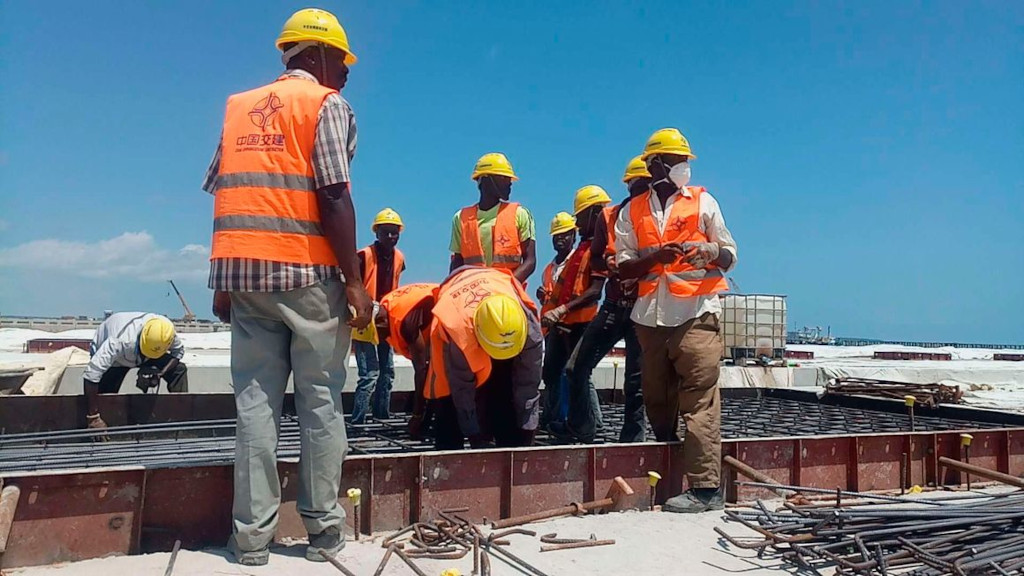Casual labourers at work at the new Lamu Port site in Kililana in Lamu West, Kenya. PHOTOS | KALUME KAZUNGU | NMG
Is Lamu Port South Sudan Ethiopia Project (Lapsset) on its way back or it is yet another episode in the fanfare associated with the project?
Observers have been wracking their brains over this after Kenya and Ethiopia, entered a deal to jointly search for a financier, and help erect one of the big-ticket projects associated with the Lapsset corridor.
Kenya’s Transport Cabinet Secretary Kipchumba Murkomen and his Ethiopian counterpart Alemu Sime signed a bilateral agreement for a standard gauge railway network between Lamu Port-Moyale-Addis Ababa.
Read: Why Lapsset is stuck on the starting blocks
“We are currently working on the development of the railway line from Lamu to Moyale through Isiolo with a link from Isiolo to Nairobi to connect with the Mombasa-Nairobi-Malaba SGR,” Murkomen said.
The move meant Nairobi had, in one month, reached out to two of its neighbours to extend the SGR to their territories from next year.
Last month, Kenya and Uganda agreed to extend the SGR from Naivasha to Kampala. They, too, agreed on a joint search for financiers, with each side footing the logistical bill on its territory.
For Lapsset, Kenya had pushed this path before.
In January 2020, Kenya, Ethiopia and South Sudan signed a memorandum of understanding for development and funding and met prospective financiers including the African Development Bank (AfDB), the United Nations Economic Mission of Africa and the African Union’s New Partnership for Africa Development (Nepad).
Read: Kenya: Ethiopia’s peace vital for development
It was then that the project was adopted as an African Union project and redesigned to link the Lamu port on the eastern African Coast of the Indian Ocean to Douala port in the western Africa Atlantic Ocean earmarking the project as one of the pillars in the realisation of the African Continental Free Trade Area (AfCFTA).
Some of the projects under the Presidential Infrastructure Champion Initiative being considered by the AU included the Nigeria-Algeria gas pipeline project (Trans-Sahara Gas Pipeline); Missing links on the Trans-Sahara highway and optic fibre link between Algeria and Nigeria; Dakar-Ndjamena-Djibouti road/rail project.
Others are North-South Corridor Road/rail project; Kinshasa-Brazzaville bridge road/rail project; unblocking political bottlenecks for ICT broadband and optic fibre projects linking neighbouring states and construction of navigational line between Lake Victoria and the Mediterranean Sea.
But previous delays in buy-in have often derailed the Lapsset project whose entire infrastructure was meant to cost $22 billion as at 2012 when it was launched. At the time, countries agreed on crowdfunding for their specified projects on their territories.
In January 2020, Kenya, Ethiopia and South Sudan agreed on joint budgetary allocation to establish a coordinating structure to accelerate infrastructure projects.
Read: Lapsset project adopted by AU to boost free trade area
Today, very little has been achieved. South Sudan has, in fact, preferred the Northern Corridor to Lamu corridor.
Increasing insecurity has also discouraged implementation or simply diverted attention of governments. Al Shabaab attacks in Lamu, South Sudan’s civil war and civil strife in Ethiopia have all come in since 2020.
At last week’s meeting, Kenya and Ethiopia came up with a working committee.
“We further agreed to establish a Bilateral Steering Committee comprising officials from Kenya and Ethiopia to fast-track the development of the Lapsset Corridor and its supporting infrastructure,” said Mr Murkomen.
As in the case of Uganda, Kenya is this time providing enticements to Ethiopia. Those privileges include a special yard as well as stationed customs officials should Ethiopia choose to use Lamu in future, for imports.
For Ethiopia, its buy-in into the project is important to revive Lapsset. Kenya recently completed three berths of the new Lamu Port worth $400 million and is expected to serve as a transshipment facility and import port for southern Ethiopia.
Source: The East African, 19th August 2024
 afric-Invest
afric-Invest